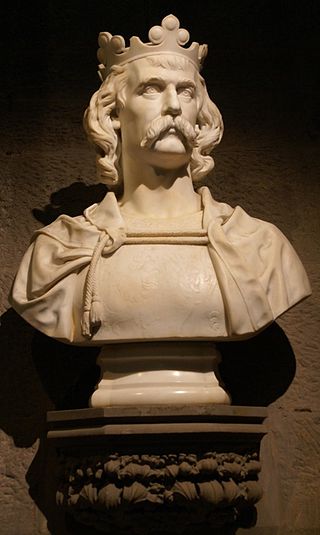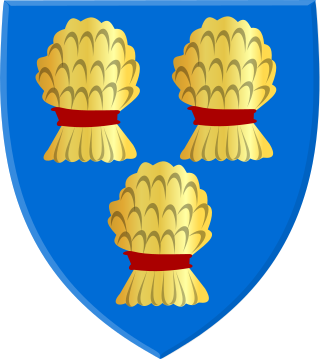Related Research Articles

Robert I, popularly known as Robert the Bruce, was King of Scots from 1306 to his death in 1329. Robert led Scotland during the First War of Scottish Independence against England. He fought successfully during his reign to restore Scotland to an independent kingdom and is regarded in Scotland as a national hero.

Baron is a rank of nobility or title of honour, often hereditary, in various European countries, either current or historical. The female equivalent is baroness. Typically, the title denotes an aristocrat who ranks higher than a lord or knight, but lower than a viscount or count. Often, barons hold their fief – their lands and income – directly from the monarch. Barons are less often the vassals of other nobles. In many kingdoms, they were entitled to wear a smaller form of a crown called a coronet.
The Peerage of Ireland consists of those titles of nobility created by the English monarchs in their capacity as Lord or King of Ireland, or later by monarchs of the United Kingdom of Great Britain and Ireland. It is one of the five divisions of Peerages in the United Kingdom. The creation of such titles came to an end in the 19th century. The ranks of the Irish peerage are duke, marquess, earl, viscount and baron. As of 2016, there were 135 titles in the Peerage of Ireland extant: two dukedoms, ten marquessates, 43 earldoms, 28 viscountcies, and 52 baronies. However, these titles have no official recognition in the Republic of Ireland, with Article 40.2 of the Constitution of Ireland forbidding the state conferring titles of nobility and stating that an Irish citizen may not accept titles of nobility or honour except with the prior approval of the Irish government.

The Peerage Act 1963 is an Act of the Parliament of the United Kingdom that permits women peeresses and all Scottish hereditary peers to sit in the House of Lords and allows newly inherited hereditary peerages to be disclaimed.

John Comyn III of Badenoch, nicknamed the Red, was a leading Scottish baron and magnate who played an important role in the First War of Scottish Independence. He served as Guardian of Scotland after the forced abdication of his uncle, King John Balliol, in 1296, and for a time commanded the defence of Scotland against English attacks. Comyn was stabbed to death by Robert the Bruce before the altar at the church of the Greyfriars at Dumfries, once it had been declared that Comyn had more connection to King David of Scotland and therefore should be the next King of Scotland, not Robert.

Alexander Stewart, Earl of Buchan, called the Wolf of Badenoch, was a Scottish royal prince, the third son of King Robert II of Scotland by his first wife Elizabeth Mure. He was Justiciar of Scotia and held large territories in the north of Scotland.

Kirkintilloch is a town and former barony burgh in East Dunbartonshire, Scotland. It lies on the Forth and Clyde Canal and on the south side of Strathkelvin, about 8 miles (13 km) northeast of central Glasgow. Historically part of Dunbartonshire, the town is the administrative home of East Dunbartonshire council area, its population in 2009 was estimated at 19,700 and its population in 2011 was 19,689.

In Scotland, the Baronage refers to the class of barons and baronesses who are the heads of their respective baronies. Also known as prescriptive baronies, they used to be attached to a particular piece of land on which was situated the caput or essence of the barony, normally a building, such as a castle or manor house. Accordingly, the owner of the piece of land containing the caput was called a baron or baroness. According to Grant, there were around 350 identifiable local baronies in Scotland by the early fifteenth century and these could mostly be mapped against local parish boundaries.

Lenzie is a town by the Edinburgh and Glasgow Railway in the East Dunbartonshire council area of Scotland. It is about 6 miles (10 km) north-east of Glasgow city centre and 1 mile (2 km) south of Kirkintilloch. At the 2011 census, it had a population of 8,873. The ancient barony of Lenzie was held by William de Comyn, Baron of Lenzie and Lord of Cumbernauld in the 12th century.
William of Mar, also known by the name Uilleam mac Dhonnchaidh, was the mormaer of Mar in medieval Scotland from 1244 to 1276. His father was Donnchadh of Mar.

Fetteresso Castle is a 14th-century tower house, rebuilt in 1761 as a Scottish Gothic style Palladian manor, with clear evidence of prehistoric use of the site. It is situated immediately west of the town of Stonehaven in Kincardineshire, slightly to the west of the A90 dual carriageway. Other notable historic fortified houses or castles in this region are Dunnottar Castle, Muchalls Castle, Fiddes Castle, Cowie Castle and Monboddo House.
A barony is an administrative division of a county in Scotland, Ireland, outlying parts of England and historically France and Sardinia. As a barony is associated to a Baron and a county to a Count or Earl, it has a lower rank and importance than a county.

Clan Strachan is a Scottish clan originating from the barony of Strachan, in Aberdeenshire. The clan does not have a chief, therefore it is considered by Court of the Lord Lyon and the Stand Council of Scottish Chiefs as an Armigerous clan.

Clan Kirkpatrick is a Lowland armigerous Scottish clan. There are several variations of the Kirkpatrick name: Kilpatric, Kilpatrick, and Gilpatrick. The names Kirkpatrick and Kilpatrick may have been interchangeable at one time. The clan is recognised by the Court of the Lord Lyon, however the clan does not currently have a chief so recognised. The surname Kirkpatrick is also a recognized sept of Clan Douglas and Clan Colquhoun.
Baron of Plenderleith is an ancient title of nobility in the Baronage of Scotland.
Alice Comyn, Countess of Buchan, Lady Beaumont was a Scottish noblewoman, a member of the powerful Comyn family which supported the Balliols, claimants to the disputed Scottish throne against their rivals, the Bruces. She was the niece of John Comyn, Earl of Buchan, to whom she was also heiress, and after his death the Earldom of Buchan was successfully claimed by her husband Henry de Beaumont, Earl of Buchan, by right of his wife. His long struggle to claim her Earldom of Buchan was one of the causes of the Second War of Scottish Independence.

William de Valognes also known as William de Valoynes, was the only son of Philip de Valognes and was granted a charter of the baronies of Panmure and Benvie by King William the Lion, previously granted to his father. On his father's death in 1215, William de Valongnes was made High Chamberlain to Alexander II. He died in 1219 and was interred at Melrose Abbey.
Baron of Kirkintilloch (extinct) was a title of nobility in the Baronage of Scotland for the holder of the barony with its caput baronium originally at Kirkintilloch Castle in East Dunbartonshire. The barony was granted to William Comyn, Baron Lenzie in 1184. After the Comyns were disinherited by King Robert the Bruce, the barony was given to the Fleming family after 1306.
Baron of Cumbernauld (extinct) was a title of nobility in the Baronage of Scotland for the holder of the barony with its caput baronium originally at Cumbernauld Castle in North Lanarkshire, Scotland. The barony was held by the Comyn family, was forfeited in 130 .and was granted to the Fleming family in 1314.
References
- Boardman, Steve, et al. The Exercise of Power in Medieval Scotland, C. 1200-1500; Four Courts (2003) ISBN 9781851827497